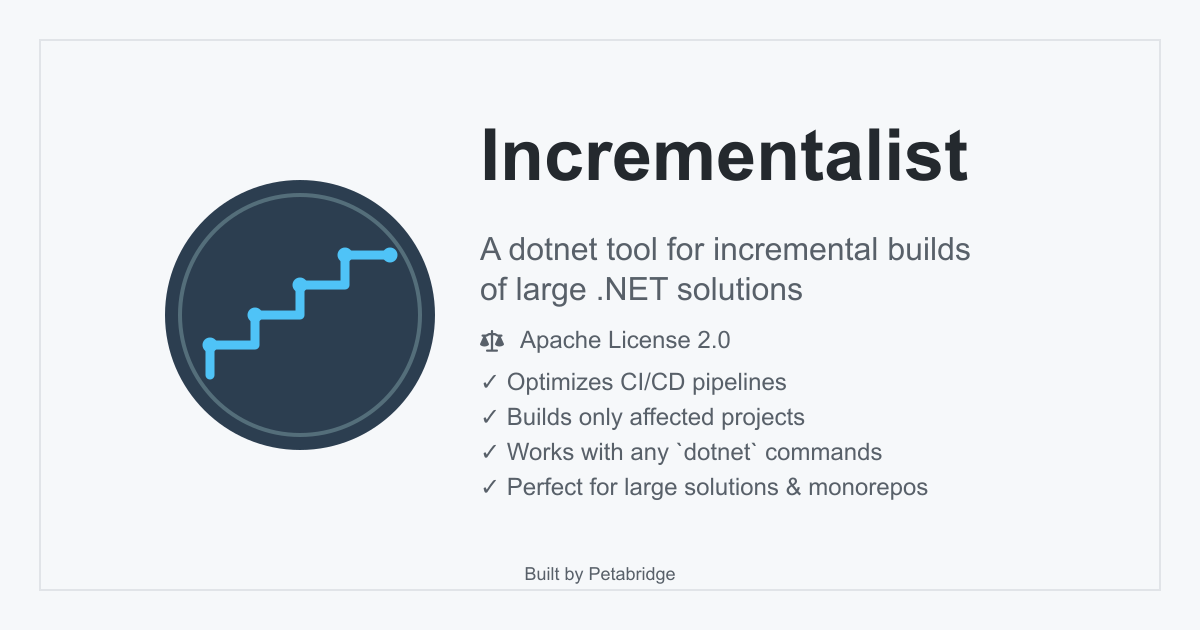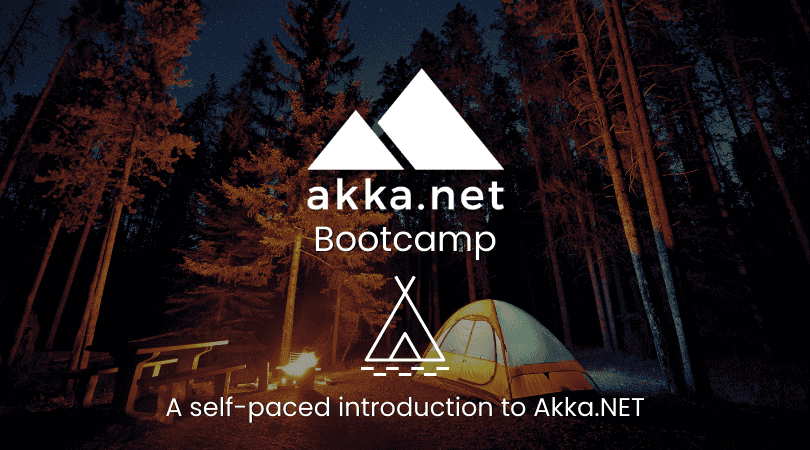Introducing Incrementalist, an Incremental .NET Build Tool for Large Solutions
Reduced Akka.NET's average build time from ~1.25hrs to 15 minutes.
12 minutes to readWe blog a ton about Akka.NET here, but Petabridge really is a .NET open source company. Throughout our work on Akka.NET we create many other OSS tools in support of much more general purpose .NET use cases, such as the .NET Runtime Dashboards we touted on our YouTube channel a couple of weeks ago or, back in the day, tools like NBench1.
Today though we’re writing about a brand new tool we’ve been working on for the past several months: Incrementalist v1.0, a command-line tool that leverages git and Roslyn solution analysis to drastically reduce build times for large .NET solutions and monorepos.
We’ve been using older versions of Incrementalist in production inside the Akka.NET build pipeline since 2019 - it cuts our average pull request build time down from about 1 hour and 15 minutes to ~15 minutes. Those older versions of Incrementalist just spat out the smallest possible build graphs as a .csv file - it was up to you to parse it and use the data accordingly.
Incrementalist v1.0 is a totally different animal: it runs the dotnet commands for you.
For example, from Akka.NET’s live build system:
dotnet incrementalist run --config .incrementalist/testsOnly.json -- test -c Release --no-build --framework net8.0 --logger:trx --results-directory TestResults This call:
- Invokes the
runverb - which means we’re going to execute adotnetcommand against all of the matching projects (C# or F#); - Uses the
Retiring Akka.Persistence.SqlServer, Postgres, Sqlite
Akka.Persistence.Sql is the new flavor moving forward.
8 minutes to readIt was just about 10 years ago when we shipped Akka.NET v1.0.2, the release where we first introduced betas of some of our most popular Akka.Persistence plugins: Akka.Persistence.Postgres, Akka.Persistence.SqlServer, and Akka.Persistence.Sqlite.
All of these plugins were based off of a shared ADO.NET Akka.Persistence architecture called Akka.Persistence.Sql.Common and this architecture has served both us and our users / customers well over the past 10 years, somewhere to the tune of 1.6 million installations!
But, as of Akka.NET v1.5.40 these plugins are all deprecated in favor of Akka.Persistence.Sql - the successor plugin for all SQL RDBMS we introduced along with the release of Akka.NET v1.5.
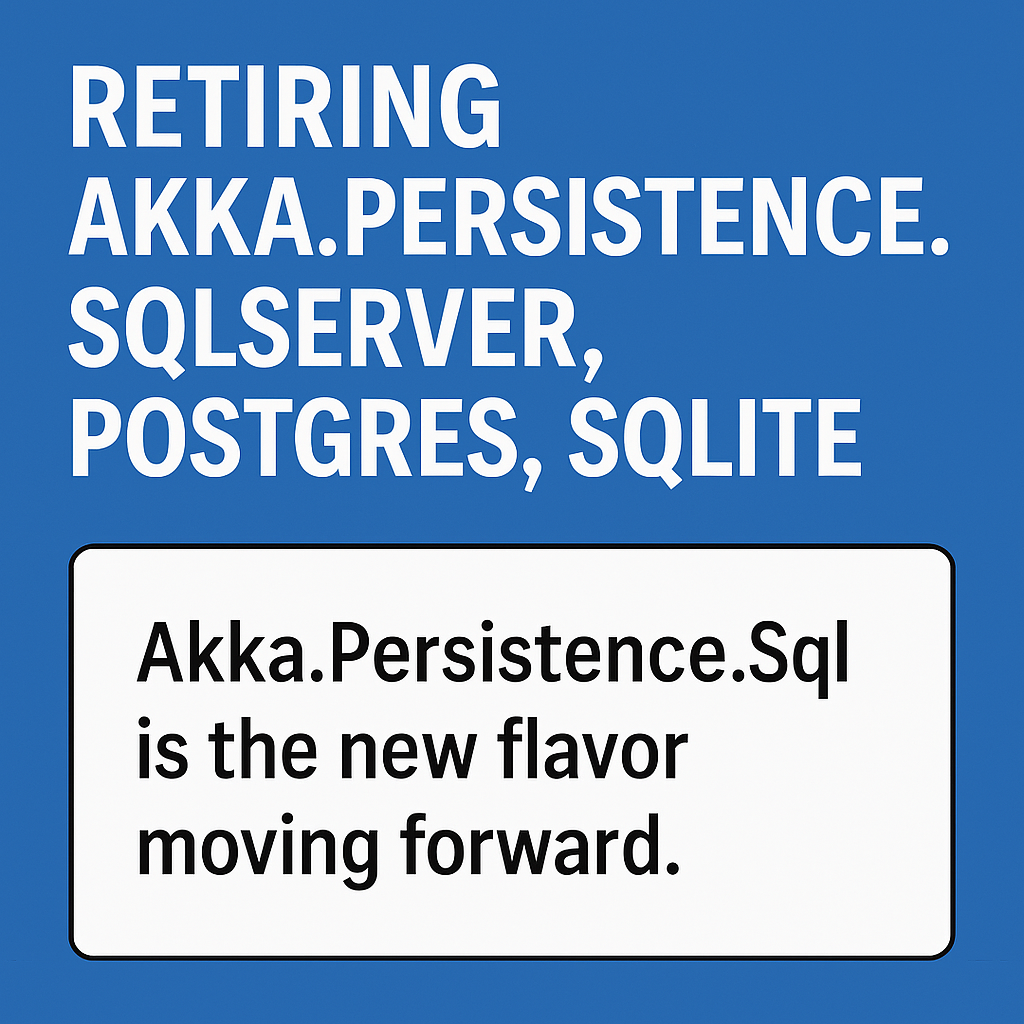
In the next sections we’ll explain our decision along with showing you our migration guide for moving off any of the affected Akka.Persistence.Sql.Common plugins and onto Akka.Persistence.Sql.
.NET Heisenbug Mystery Theater: How Did an Exception Escape its Catch Block?
A painful lesson on atomicity and the assignment of structs.
21 minutes to readOver the past several months the Akka.NET team has had reports of the following Exception popping up unexpectedly throughout many of our plugins and end-user applications that use the Akka.Streams1 SelectAsync stage - such as Akka.Streams.Kafka and Akka.Persistence.Sql:
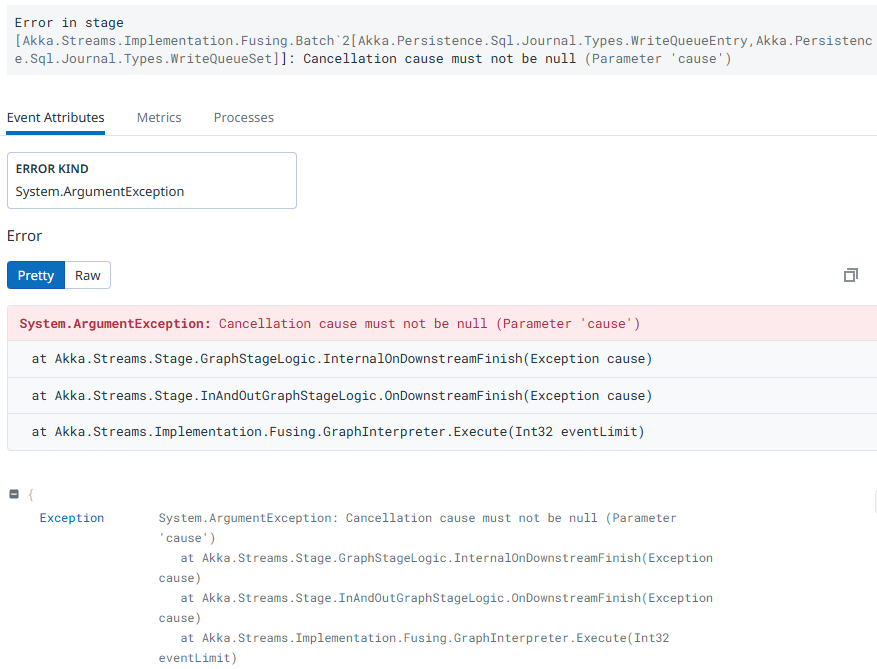
That error message seems simple enough - it comes from here inside GraphStage.cs:
[InternalApi] public void InternalOnDownstreamFinish(Exception cause) { try { if (cause == null) throw new ArgumentException("Cancellation cause must not be null", nameof(cause)); In Akka.Streams parlance, a stream gets cancelled when an unhandled Exception is thrown and that error should be propagated all the way down to this GraphStage.InternalOnDownstreamFinish method so we can log why the stream is being cancelled / terminated.
Here’s the mystery - this is the code that “threw” the Exception inside Akka.Persistence.Sql for instance:
.SelectAsync( JournalConfig.DaoConfig.Parallelism, async promisesAndRows => { try { await WriteJournalRows(promisesAndRows.Rows); foreach (var taskCompletionSource in promisesAndRows.Tcs) taskCompletionSource.TrySetResult(NotUsed.Instance); } catch (Exception e) { foreach (var taskCompletionSource in promisesAndRows.Tcs) taskCompletionSource.TrySetException(e); } return NotUsed.Instance; }) Introducing Akka.NET Bootcamp 2.0
Modern Akka.NET Best Practices in Free, Self-Paced Lessons
2 minutes to readAkka.NET Bootcamp has a special place in my heart because it’s really “the thing” that launched Petabridge as a business 10 years ago.
However, the original Akka.NET Bootcamp should have really been replaced years ago as both Akka.NET and the .NET ecosystems had changed tremendously since it was originally written.
So on that long-overdue note, it’s my pleasure to announce that the first two units of Akka.NET Bootcamp 2.0 are now live and available for immediate consumption!
Here’s what’s new in Bootcamp 2.0:
10 Important Engineering Lessons Learned Over 10 Years of Petabridge
Petabridge turns 10 in January 2025!
1 minute to readWhen we first started Petabridge in January 2015, I never imagined that we’d be at this for 2-3 years, let alone 10! But here we are. It’s been an amazing journey and our privilege to work with so many amazing customers and software developers on building some of the world’s most important software on top of Akka.NET.
I already published a small post on my personal website about the business side of running Petabridge over this span of time, but for our subscribers and Akka.NET users here at Petabridge, I thought it’d be more appropriate to share some of the engineering lessons we’ve learned over the course of 10 years from all of our experiences here.
Please enjoy “10 Most Important Engineering Lessons Learned from 10 Years of Petabridge”.
The Lessons
We’re kicking off 2025 with a fresh look at Akka.NET and what we have planned for our next big release: Akka.NET v1.6!
Akka.NET v1.6: a Performance-Focused Release
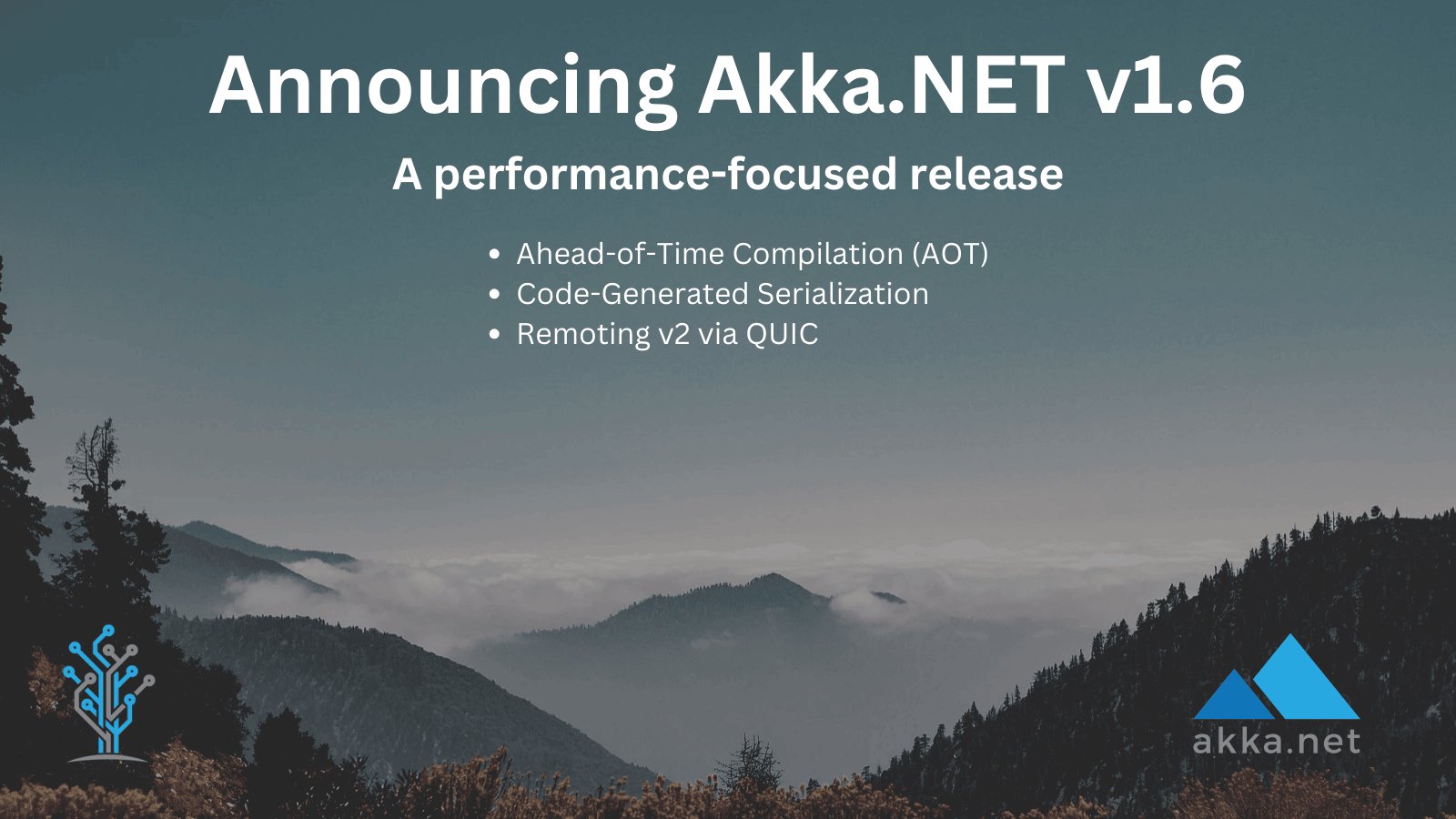
As it says in our promo image here - Akka.NET v1.6 is a performance-focused release. To that end, we’re addressing the following three major changes:
How to Start Learning Actor-Based Programming
Discovering and appreciating differences between Akka.NET actors and traditional Object-Oriented Programming
7 minutes to readOne of the most frequent pieces of feedback we get from developers who are new to Akka.NET is that the “learning curve” is high. I want to explore that today and why I think this isn’t actually true, but what developers are saying is that working with actors is unfamiliar, not difficult.
I’d also argue that really, really bad pre-existing habits many software developers have, such as frameworkism, become a hundred-fold more destructive when you introduce unfamiliar paradigms, such as stateful programming with actors, to the mix. You could substitute “stateful programming with actors” with “using NoSQL” or “going cloud native” and that sentence would be equally true.
Let’s assume you’ve already decided that learning actors is worth your time and now you want to know: “how can I begin to learn how to work with actors for my own purposes?” That’s what this post is about.
Why IActorRef.Tell Doesn't Return a Task
Nuances of actor-based programming in .NET
9 minutes to readA really, really common question Akka.NET beginners have within the first couple of hours of looking at Akka.NET: “how is the IActorRef.Tell method asynchronous if it’s a void method? Shouldn’t it return a Task I can await on?”
Today I’m going to clarify Akka.NET’s API design and explain, in terms of Akka.NET’s behavior and benefits to users, why we don’t do this.
Even if you’re a seasoned Akka.NET user, you might find some value in this post.
Akka.NET Actors' Hidden Super Power: Behavior Switching
Making the Complex Understandable
13 minutes to readWe put together a new YouTube video on our Petabridge channel (which you should subscribe to) yesterday, “Akka.NET Actors’ Hidden Super Power: Switchable Behaviors” - all about one of my favorite features in Akka.NET: the Become method for swapping actor message-processing behavior dynamically at runtime.
In addition to the video, I wanted to expand on why behavior-switching is so powerful and how you can use it to transform inherently complex domain problems into something that is approachable, understandable, and expressable with a very small amount of purpose-built code.
The Worst .NET Bug I've Ever Fixed
A 70+ hour journey into fixing a ~10 year old Akka.NET bug.
9 minutes to readThe month of July, 2024 was pretty rough for me and the Petabridge crew from a workload standpoint. Our office got hit with a hurricane. My entire family and I were out sick with COVID in the middle of being hit by a hurricane. Fun times.
But the worst of it was a pair of truly nasty Akka.NET issues that both turned out to both be the same bug:
- Akka.Cluster.Sharding: duplicate shards / entities
- Akka.Cluster.Tools.Singleton: singleton moves earlier than expected - as soon as new node joins
I ended up spending about 70+ hours myself investigating and eventually solving this bug starting from June 27th onwards.
If you’re an Akka.NET user and don’t want to read any further, just upgrade to Akka.NET v1.5.27 or later - the bugs are fixed in those versions of the software. Every other earlier version of the software, dating back to when Akka.Cluster.Tools was first introduced in 2015, has this bug. Please upgrade now.
Otherwise, read on.
